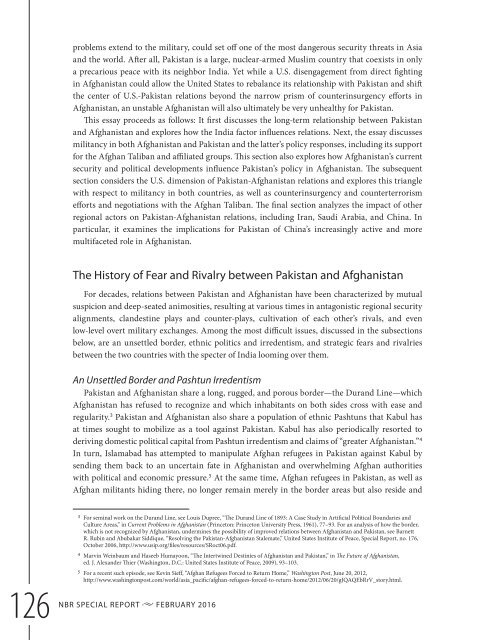pakistan’s
SR55_Mapping_Pakistan_February2016
SR55_Mapping_Pakistan_February2016
You also want an ePaper? Increase the reach of your titles
YUMPU automatically turns print PDFs into web optimized ePapers that Google loves.
problems extend to the military, could set off one of the most dangerous security threats in Asia<br />
and the world. Ater all, Pakistan is a large, nuclear-armed Muslim country that coexists in only<br />
a precarious peace with its neighbor India. Yet while a U.S. disengagement from direct fighting<br />
in Afghanistan could allow the United States to rebalance its relationship with Pakistan and shit<br />
the center of U.S.-Pakistan relations beyond the narrow prism of counterinsurgency efforts in<br />
Afghanistan, an unstable Afghanistan will also ultimately be very unhealthy for Pakistan.<br />
This essay proceeds as follows: It first discusses the long-term relationship between Pakistan<br />
and Afghanistan and explores how the India factor influences relations. Next, the essay discusses<br />
militancy in both Afghanistan and Pakistan and the latter’s policy responses, including its support<br />
for the Afghan Taliban and affiliated groups. This section also explores how Afghanistan’s current<br />
security and political developments influence Pakistan’s policy in Afghanistan. The subsequent<br />
section considers the U.S. dimension of Pakistan-Afghanistan relations and explores this triangle<br />
with respect to militancy in both countries, as well as counterinsurgency and counterterrorism<br />
efforts and negotiations with the Afghan Taliban. The final section analyzes the impact of other<br />
regional actors on Pakistan-Afghanistan relations, including Iran, Saudi Arabia, and China. In<br />
particular, it examines the implications for Pakistan of China’s increasingly active and more<br />
multifaceted role in Afghanistan.<br />
The History of Fear and Rivalry between Pakistan and Afghanistan<br />
For decades, relations between Pakistan and Afghanistan have been characterized by mutual<br />
suspicion and deep-seated animosities, resulting at various times in antagonistic regional security<br />
alignments, clandestine plays and counter-plays, cultivation of each other’s rivals, and even<br />
low-level overt military exchanges. Among the most difficult issues, discussed in the subsections<br />
below, are an unsettled border, ethnic politics and irredentism, and strategic fears and rivalries<br />
between the two countries with the specter of India looming over them.<br />
An Unsettled Border and Pashtun Irredentism<br />
Pakistan and Afghanistan share a long, rugged, and porous border—the Durand Line—which<br />
Afghanistan has refused to recognize and which inhabitants on both sides cross with ease and<br />
regularity. 3 Pakistan and Afghanistan also share a population of ethnic Pashtuns that Kabul has<br />
at times sought to mobilize as a tool against Pakistan. Kabul has also periodically resorted to<br />
deriving domestic political capital from Pashtun irredentism and claims of “greater Afghanistan.” 4<br />
In turn, Islamabad has attempted to manipulate Afghan refugees in Pakistan against Kabul by<br />
sending them back to an uncertain fate in Afghanistan and overwhelming Afghan authorities<br />
with political and economic pressure. 5 At the same time, Afghan refugees in Pakistan, as well as<br />
Afghan militants hiding there, no longer remain merely in the border areas but also reside and<br />
126<br />
NBR<br />
3 For seminal work on the Durand Line, see Louis Dupree, “The Durand Line of 1893: A Case Study in Artificial Political Boundaries and<br />
Culture Areas,” in Current Problems in Afghanistan (Princeton: Princeton University Press, 1961), 77–93. For an analysis of how the border,<br />
which is not recognized by Afghanistan, undermines the possibility of improved relations between Afghanistan and Pakistan, see Barnett<br />
R. Rubin and Abubakar Siddique, “Resolving the Pakistan-Afghanistan Stalemate,” United States Institute of Peace, Special Report, no. 176,<br />
October 2006, http://www.usip.org/files/resources/SRoct06.pdf.<br />
4 Marvin Weinbaum and Haseeb Humayoon, “The Intertwined Destinies of Afghanistan and Pakistan,” in The Future of Afghanistan,<br />
ed. J. Alexander Thier (Washington, D.C.: United States Institute of Peace, 2009), 93–103.<br />
5 For a recent such episode, see Kevin Sieff, “Afghan Refugees Forced to Return Home,” Washington Post, June 20, 2012,<br />
http://www.washingtonpost.com/world/asia_pacific/afghan-refugees-forced-to-return-home/2012/06/20/gJQAQEbRrV_story.html.<br />
SPECIAL REPORT u FEBRUARY 2016



